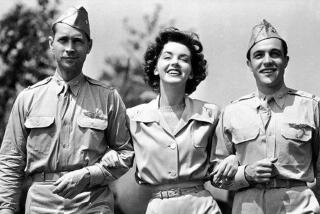Betty Hutton, 86; star of Hollywood musicals, comedies in ‘40s and ‘50s
- Share via
Betty Hutton, the exuberant singer-actress who shot to Hollywood fame in the 1940s in musicals and comedies such as the madcap classic “The Miracle of Morgan’s Creek,” has died. She was 86.
Hutton died in her Palm Springs apartment Sunday night from complications of colon cancer, Carl Bruno, her longtime friend and executor, told The Times on Tuesday.
Although an unidentified source had reported Hutton’s death to the Associated Press late Monday, official confirmation and details were withheld until after her funeral Tuesday.
“She wanted to have everything totally private, and we tried to respect her wishes,” Bruno said.
Veteran Paramount producer A.C. Lyles told The Times on Tuesday that “Betty Hutton was one of the most popular stars we ever had on the Paramount lot. Everyone adored Betty.”
During Hutton’s heyday at Paramount in the ‘40s, her high-energy performing style earned her nicknames such as “the Blond Bombshell” and “the Blond Blitz.”
“If they put a propeller on Hutton and sent her over Germany, the war would be over by Christmas,” Bob Hope joked at the time.
Hutton was best known for belting out lively tunes, delivered with appropriately animated body English, such as “Murder, He Says” and “Doctor, Lawyer, Indian Chief.”
But Hutton “wasn’t all just a zany comedian,” said Turner Classic Movies host Robert Osborne, who did a rare on-camera interview with Hutton in 2000.
“The thing about Betty Hutton was she could also sing a song and break your heart, and she was a very good actress,” Osborne said Tuesday. “Behind the zaniness there was a very sweet, vulnerable person; and there was that in real life as well.”
One of Hutton’s greatest screen triumphs came in 1950 when she starred as Annie Oakley in the Irving Berlin musical “Annie Get Your Gun,” which landed her on the cover of Time magazine.
She followed that by starring as a trapeze artist in Cecil B. DeMille’s 1952 drama “The Greatest Show on Earth,” winner of the best picture Oscar.
But Hutton’s movie career ended a short time later. Although she cashed in on her movie fame performing a nightclub act in Las Vegas, New York and Europe and made a stab at a television series, she virtually disappeared from the limelight.
In 1974, however, she generated headlines when she was discovered in an unlikely venue: the rectory of St. Anthony’s Church in Portsmouth, R.I., where she had begun working after meeting a Catholic priest when she was in detox for an addiction to sleeping pills and other drugs.
By then she had endured four failed marriages, bankruptcy, the death of her mother in a fire and estrangement from her three daughters.
“I don’t want to go into how I got here,” Hutton told a reporter at the time. “I was a brokenhearted woman and didn’t want to live anymore. I should be dead, but I’m not.”
Born Betty June Thornburg on Feb. 26, 1921, in Battle Creek, Mich., Hutton never really knew her father, a railroad brakeman who reportedly walked out on her mother, Mabel, when Betty was 2 and her sister, Marion, was 3.
To support her two daughters, Mabel made and sold bathtub gin and beer during Prohibition in their Lansing, Mich., home.
As a young child, Betty earned spare change singing for her mother’s customers.
After a police raid, Hutton’s mother fled with her children to Detroit, where she got a job working in a Chrysler factory. To help make ends meet, Betty sang on street corners and in the bars where her mother drank.
In 1936, the 15-year-old Hutton took a $15-a-week summer job at a lake resort singing with a local band.
She was singing in a Detroit nightclub about a year later when she was hired by bandleader Vincent Lopez, who changed her name to Hutton.
Her sister, who became a vocalist with the Glenn Miller Orchestra, also adopted the name.
After a smash engagement at Billy Rose’s Casa Manana nightclub in New York in 1938, a vaudeville tour with the band and appearances on Lopez’s late-evening radio show, Hutton struck out on her own in 1940.
She made her Broadway stage debut early that year in the musical revue “Two for the Show,” wowing the critics with her “riotous” performance.
She followed that up later in the year with a supporting role in “Panama Hattie,” a long-running Cole Porter Broadway musical hit starring Ethel Merman.
When “Hattie” producer B.G. “Buddy” DeSylva became head of production at Paramount Studios in late 1941, he brought Hutton to Hollywood with the promise of making her a star.
One of Hutton’s most memorable film performances was one in which she did not sing: “The Miracle of Morgan’s Creek,” the 1944 Preston Sturges war-time comedy co-starring Eddie Bracken.
Hutton plays a small-town music store clerk who spends the night dancing with overseas-bound GIs, accidentally gets a knock on the head, wakes up married, with no idea of the bridegroom’s identity -- and soon learns that she is pregnant with what turns out to be sextuplets.
“She was absolutely wonderful in ‘Miracle of Morgan’s Creek,’ ” film critic and author Richard Schickel told The Times several years ago. “There was something sort of delicious about her ditziness, her inability to remember who” got her pregnant.
In 1945, Hutton portrayed entertainer Texas Guinan in the musical biography “Incendiary Blonde.” Two years later, she starred in “The Perils of Pauline,” a comedy biopic of silent serial star Pearl White.
But the one role Hutton yearned to play was Annie Oakley in the screen version of “Annie Get Your Gun,” the Broadway hit that starred Ethel Merman in the title role.
“Annie Get Your Gun,” which Hutton made on loan to MGM, was a major success, reinvigorating Hutton’s career.
Returning to Paramount, Hutton went on to star in “The Greatest Show on Earth,” for which she learned to do trapeze work for her role as an aerialist.
Her final picture at Paramount was “Somebody Loves Me,” a 1952 biopic of vaudeville star Blossom Seeley.
By then, the studio reportedly was giving her substandard scripts. And after Paramount refused Hutton’s demand to have her second husband, choreographer Charles O’Curran, direct her next picture, she walked out on her contract. She would make only one more picture, the low-budget drama “Spring Reunion” with Dana Andrews, in 1957.
Her movie career over, Hutton gave television a try. In 1959, she starred in the short-lived situation comedy “The Betty Hutton Show.”
In 1962, Hutton’s mother, her constant companion on her tours, died in a fire in her Hollywood home.
After her mother’s death, Hutton said, “I lost faith in me, and when I lost it, everybody else did” too.
In 1967, Hutton filed for bankruptcy, reportedly having gone through career earnings of more than $9 million. That year, her marriage to her fourth husband, trumpeter Pete Candoli, ended in divorce. Her previous marriages to O’Curran, camera manufacturer Ted Briskin and Capitol Records executive Alan Livingston had also ended in divorce.
Plagued with insomnia, she took sleeping pills and, she later told the Associated Press, “I couldn’t get off of them.”
Then came her chance meeting in 1974 at a Boston detox hospital with Father Peter Maguire, who had brought in his cook for alcohol treatment. Hutton became friends with the cook and began working as a housekeeper in the rectory of Maguire’s church. With Maguire as her spiritual advisor, she converted to Catholicism.
“I couldn’t have found me if I hadn’t found” Maguire, she told a reporter. But her work at the rectory lasted only a few months. In December 1974, with Hutton reportedly suffering from “a complete emotional breakdown,” her psychiatrist had her committed to a psychiatric hospital for several weeks.
Hutton, who continued to live in Rhode Island over the next two decades, eventually began to rebuild her life.
She made occasional show business comebacks, appearing in plays in Louisville, Ky., and San Francisco, and in 1980 she played the mean orphanage boss in a limited run of “Annie” on Broadway.
Under Maguire’s guidance, Hutton also finished her high school education and earned a college degree.
In the mid-1980s, she became a faculty member at Salve Regina University in Newport, R.I., where she taught classes in TV and motion pictures.
Reportedly devastated by the death of her beloved mentor, Maguire, in 1996, Hutton moved to Palm Springs.
She is survived by three daughters and a number of grandchildren and great-grandchildren.
A memorial service will be held at 11 a.m. March 23 at St. Theresa Catholic Church, 2800 E. Ramon Road, Palm Springs.
*


